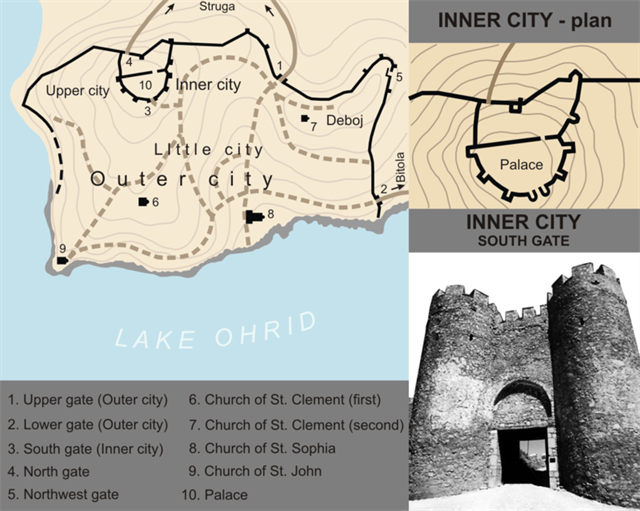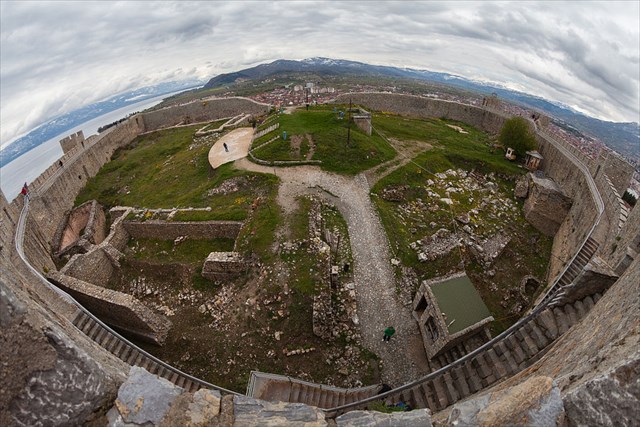Samuil Fortress
There are many ways to explore Ohrid, to learn about its history and to enjoy all gifts it offers. You might prefer to experience this town more materially – its position at the foot of the Galichitsa Mt., the crystal air, the unrepeatable and unique beauty of the lake, the shops full of irresistible masterpieces of Ohrid craftsmen, tasty food etc. Some people prefer to experience Ohrid spiritually – to immerse into the gloom of its churches and monasteries, where the silence gently pulsates of the liturgies sung during centuries, the frescoes tell stories about born of Christianity, where icons will enchant you with profundity, sadness and eternal love of eyes of Holy Mother and Her Son…
It is up to you to choose. Whatever you decide, enjoy and remember your visit to this special spot on the Earth…
About this cache:The fortress in Ohrid was named after Tsar Samuil due the fact that one period of his region he had chosen Ohrid as the capital of his kingdom (10th and early 11thcentury). The fortress is a profane construction inseparably connected with the entire history of Ohrid from the oldest periods till day. The town Lychnidos and the fortress for the first time where mentioned by Livy in 209 B.C., during the region of the Macedonian king Philip V. This data tells that at the end of the 3rd century B.C., the fortress was fully erected and functioned in the crucial moments in the history of the town Lychnidos (Ohrid). The present day appearance of the fortress with its size most probably was established in the 4th century A.D.
The fortress, depending on the historical circumstances, was more or less in focus, was restored or demolished. Nevertheless, its surface from time of the Late Antiquity remained generally unchanged. In the late 10th and early 11thcentury, during the rule of Tsar Samuil, Ohrid became the capital of the first Macedonian – Slavic kingdom.
The sheme of Samuil Fortress

After the Ottomans sized Ohrid, a military unit was stationed inside the fortress. At last, in the late 18th century, the self – willed ruler Jeladin bay who “at the same time demolished and build” has been credited for significant interventions on the fortress citadel. During these activities, in 1880 he erected a Saray (palace) in the south section. From this period it became customary the citadel to be called “Gorni (Upper) Saray”. With this ends the historic role of Samuel’s fortress. In 1934, King Alexander for the inhabitants of Ohrid had built a water line
A view over Samuil Fortress

The fortress walls in the Central area (the citadel, kale, Gorni Saray) are preserved and range from 10 to 18m in height. The fortress has 18 defense towers, 4 gates: Iron Gate, Upper Gate, Front Gate, Lower Gate. During the period of 2000-2002 on Samuil’s fortress were carried out the largest research and conservation restoration works. Likewise, systematic archeological excavations were undertaken on the entire citadel area, and the walls were completely restored, and on some sections the height of the walls are up to 20m. In frames of the extensive research on the area of the Upper Gate the oldest burials and the most significant archeological finds were discovered, the Golden funerary mask and the Golden glove, from the period of the 6th century and the early 5th century B.C.
About the cache: The cache is a small MAGNETIC box. It is placed INSIDE THE FORTRESS!!! The working hours of the Fortress: every day except Mondays, from 9.00 am to 7.00 pm. Entrance fee: 80 denars for local people, 120 denars for foreigners, (2 euroс).
Sources: Internet; Photos: Internet, Original (by Galejnik)